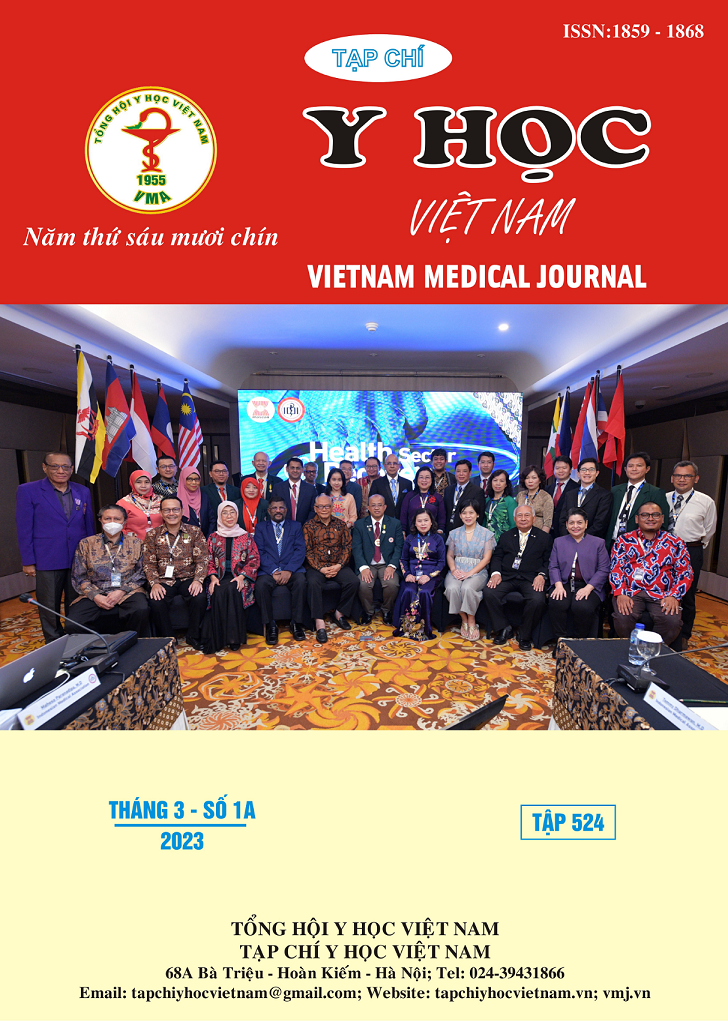EVALUATION OF THE RESULTS OF TREATMENT OF HIGH-GRACE ATRIOVENTRICULAR BLOCK WITH PERNAMENT PACEMAKER IMPLANTATION
Main Article Content
Abstract
Objective: Evaluation of treatment outcomes in patients with bradyarrhythmias due to high-grade atrioventricular block with permanent pacemaker implantation. Subjects and methods: A cross-sectional descriptive study on 38 patients with type 2 mobitz, type 2 atrioventricular block, and 3rd degree atrioventricular block at Can Tho General Hospital from 2019 to 2021. Results: 42.1% of cases were put on a temporary pacemaker. 52.6% had a permanent one-chamber pacemaker, and 47.4% had a two-chamber. 100% of the pacemaker was placed below the left clavicle. The symptoms were reduced at 1 month and 3 months after the pacemaker was implantation compared to before, significantly. The early complications recorded were bruising around the pacemaker site (15.8%); there were no late complications. The technical success proportion was 100%. The clinical success proportion was 92.1% after 3 months, and the quality-of-life improvement after 3 months was statistically significant. Conclusion: Permanent pacemaker placement for bradyarrhythmias due to atrioventricular block has a high clinical and procedural success ratio.
Article Details
Keywords
bradyarrhythmias, pacemaker, permanent
References
2. Chung Tấn Định (2018), Nghiên cứu đặc điểm lâm sàng, cận lâm sàng và kết quả điều trị rối loạn nhịp chậm bằng cấy máy tạo nhịp tim vĩnh viễn tại Bệnh viện đa khoa tỉnh Sóc Trăng, Luận văn bác sĩ chuyên khoa cấp 2, Đại học Y dược Cần Thơ.
3. Ngô Lâm Sơn (2019), Nghiên cứu đặc điểm lâm sàng, cận lâm sàng ở bệnh nhân trước và sau đặt máy tạo nhịp tim vĩnh viễn hai buồng tại bệnh viện Trung Ương Huế, Luận văn bác sĩ chuyên khoa cấp 2, Trường Đại học Y dược, Đại học Huế.
4. Nguyễn Tri Thức (2014), "Nghiên cứu đặc điểm lâm sàng, cận lâm sàng và vai trò máy tạo nhịp hai buồng trong điều trị rối loạn nhịp chậm tại Bệnh Viện Chợ Rẫy", Tạp chí Y học Thành phố Hồ Chí Minh, 18, tr. 168-174.
5. Ngô Hoàng Toàn (2022), “Nghiên cứu chất lượng cuộc sống và một số yếu tố liên quan đến sự thay đổi chất lượng cuộc sống ở bệnh nhân rối loạn nhịp chậm có chỉ định cấy máy tạo nhịp tim vĩnh viễn, Tạp chí Y học Việt Nam.
6. Andi E. Albertsen, Jens C. Nielsen et al. (2008), "Biventricular pacing preserves left ventricular performance in patients with high-grade atrio-ventricular block: a randomized comparison with DDD(R) pacing in 50 consecutive patients", European Society of Cardiology, 10, pp. 314-320.
7. Kenneth A. Ellenbogen, Karoly Kaszala (2020), Cardiac Pacing and ICDs, John Wiley & Sons Ltd, pp. 20-200.
8. Michele Brignole, Gonzalo Baron-Esquivias (2013), "ESC guideline on cardiac pacing and cardiac resynchronyzation therapy: The task for on cardiac pacing and resynchronyzation therapy for of the European Society of Cardiology (ESC)", European Society of Cardiology(15(8):1070), pp. 118.
9. Nora Golschlager, Paul Ludemretal (2017), Clinical Cardiac Pacing, 3rd Sauders Company, pp. 500-808.


